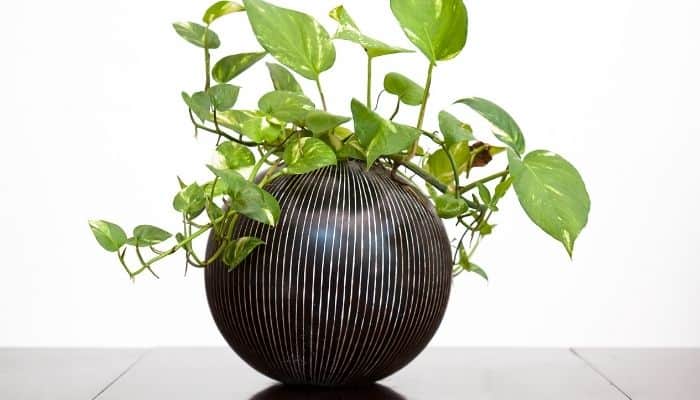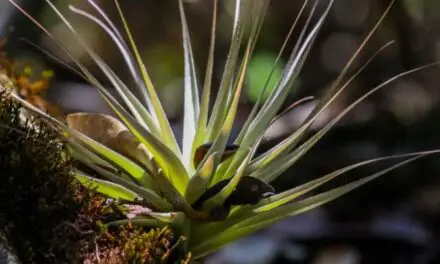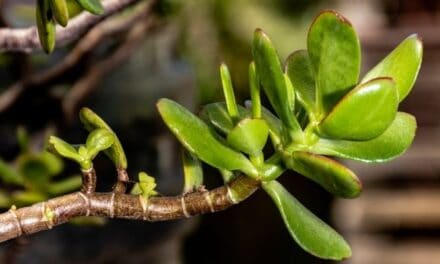If you’re trying to grow a pothos, you might be wondering why it seems slow to sprout up and turn into the beautiful big plant it should be.
There’s a lot you can do to encourage this plant to grow but there are a few key elements of care that you’ll have to pay close attention to.
Table of Contents
Why Is My Pothos Not Growing?

There are several reasons for a pothos to grow slowly, and the main ones are lack of nutrients, poor lighting, and improper watering (either too much or too little).
It’s also possible that problems such as insect infestation or the wrong temperature could be affecting your plant’s growth.
Let’s look closer at each of these issues and determine the best course of action to get your pathos growing well again.
Poor Lighting
On the whole, pothos plants manage well with low light.
They do not need a lot of sunlight because, in the natural world, they are part of the underfloor of forests, but they do still require enough light to grow properly.
If your pothos plant is growing somewhere very dark, consider moving it closer to a window to improve its growth.
These plants can handle a lot of bright light and respond to it by growing bigger leaves and more of them.
Just keep them out of direct afternoon sun as the leaves can scorch.
If you can’t get it closer to a window because you have deliberately chosen pothos to grow in a dark space, consider adding a grow lamp so that you can give the plant a little more light.
Improper Watering
It is very easy to over-water or under-water a potted plant, so if you notice your pothos isn’t growing properly, you should check its soil.
Pothos likes to be grown in damp soil, but it should be allowed to dry out between waterings, and should not be wet at all times.
Before watering, test to soil with your finger and make sure the top 1 or 2 inches have dried out before giving it more water.
If you find that the soil in the pot is too damp, you should let it dry out fully before watering the plant again.
Soil that stays wet for long periods can cause mushy, rotting roots and may kill the plant eventually.
You may find that adding water to a saucer at the bottom of the plant and letting this soak upwards helps you to more effectively water your pothos.
The soil does not want to get too dry either; if you notice the leaves looking crispy, give the plant a drink to help it grow.
Related Article: Can A Plant Live Without Leaves? (All You Need To Know)
Not Enough Nutrients
No plant will grow to its full potential if it isn’t getting enough nutrition.
To help your pothos thrive, you should feed them every 4-5 months with a liquid fertilizer.
You may also want to change its compost from time to time to ensure the soil hasn’t been drained of all its goodness, especially if the plant has been in the pot for years.
If you’re just planting pothos, put it in fresh, sterile compost so that it has a fertile growing medium to start with.
The Wrong Temperature
Like most house plants, pothos has a preferred temperature range to be kept at, if you want them to grow well.
They are happiest growing between 70°F – 90°F.
If your room is very cold, you may find that they stop growing and become dormant until temperatures warm up a bit.
Try moving them to a warmer room or turning up the heat a little.
If the room gets too hot, your pothos will probably let you know by wilting.
Try to move it somewhere cooler, away from direct sunlight (at least during the hottest part of the day), and near a cool draft if possible.
Humidity Levels Are Too Low
Pothos plants will grow bigger and bushier in conditions with higher levels of humidity.
That being said, pothos plants will grow just fine in levels of lower humidity but if you want yours to grow as big and bushy as possible, get a humidifier and raise the humidity level for your plant.
You’re Not Pruning Your Pothos
If you want your pothos to grow bigger and bushier pruning will help.
When you don’t prune this plant, it gets long and leggy, and the distance between leaves becomes greater.
When pruning, look at each vine and decide the length you’d like.
Cut the vine about a quarter-inch above the node (where the leaf meets the vine), and your pothos will send out new growth all along with the remainder of the vine, resulting in a much fuller-looking plant.
It’s Too Drafty
Pathos plants are usually not too bothered about drafts, as long as they are not too cold.
If it is freezing outside and your plant is next to a door or window and getting exposed to very cold draughts, it will most probably stunt its growth.
If this is the case, you’ll need to move it further into the room and away from drafty windows and doors.
Dusty Leaves
Over time, dust will settle and build upon your pothos’ leaves.
If this coating of dust gets too thick it will stop your plant from photosynthesizing properly and growing to its full potential.
Now and then, when you notice a bit of dust build-up, take a damp microfiber cloth and gently wipe down your plant’s leaves.
Pests
Your pathos might be suffering from an infestation that is preventing it from growing properly.
Certain insects can infest pothos plants and may cause stunted growth, malformed leaves, and dropping leaves.
You should regularly check your plant for pests, especially if it’s not looking very happy or has ceased growing.
If it’s under attack, it will be putting its energy into healing damage, not sprouting new leaves.
You may see scale insects or mealybugs on your pothos plant; both will steal the plant’s nutrients and stunt its growth.
Mealybugs are small and white, while scale insects are usually dark-colored bumps and can be hard to spot.
Treat your plant using alcohol on a cotton swab if it’s suffering from an infestation, and keep an eye on it for further problems over the next few weeks.
It should – if you have successfully removed the pests – resume normal growth quickly.
Different Varieties Of Pothos Grow At Different Rates
Pothos also comes in several different varieties, with different types requiring different amounts of light and growing at different rates.
For example, the most common type of pothos (golden pothos), is tolerant to a wide range of growing conditions and can be placed almost anywhere within your home.
But the same cannot be said for other less common varieties of pothos.
Manjula pothos plants have much lighter colored leaves than the golden pothos and they photosynthesize less.
This means that Manjula pothos needs less light but will also most likely grow at a slower rate than golden pothos – which has much darker green leaves and photosynthesizes more.
Buy A Pothos Plant With Lots Of Starters In The Pot
If you’re at the store wondering which pothos plant to buy and you have a number of similar-sized plants to choose from, choose the one that has the most starters in the pot.
The starters are the main plant stems that are growing out of the soil.
Choosing the plant with the most starters will mean that your pothos will grow bigger and bushier than the ones that have fewer.
So if you have many similar plants to choose from, count the starters in each pot and buy the one that contains the most.
This is the plant that will most likely grow to be the biggest and bushiest.
Choose How To Grow Your Pothos Plant
How you choose to grow your pothos plant will also affect how big and how fast it will grow.
These plants are long and viney and will quickly spread out of their pots.
If you put your pothos on a windowsill it will soon leave its pot and begin to grow along the bottom of your window (and may even climb up your wall).
You can also grow it in a hanging basket where it will outgrow its pot and beginning to hang its viney branches down towards the floor.
The third option for growing your pothos is the one that encourages it to grow the fastest.
In nature, these plants attach themselves to other objects such as trees and climb upwards to reach the light.
You can use a moss pole or put a circular wire mesh in the center of the pot for your pothos to climb vertically.
This is how this plant naturally likes to grow in the wild and it encourages it to grow faster and bigger.
Conclusion
Pothos plants are usually hardy and easy to grow, so if you’re having problems, check the above five categories to see if any are causing issues.
Remember, there may be multiple areas you need to address to get your plant back to vigorous, healthy growth.




